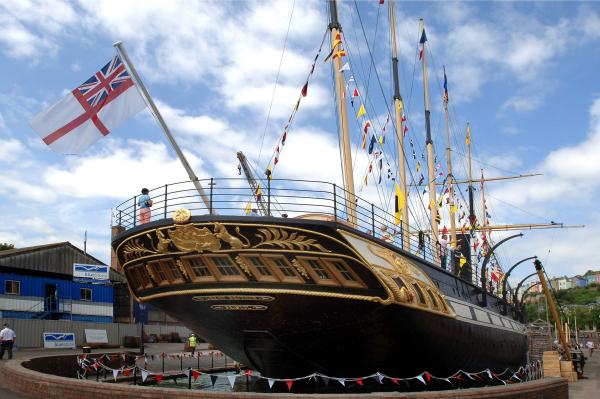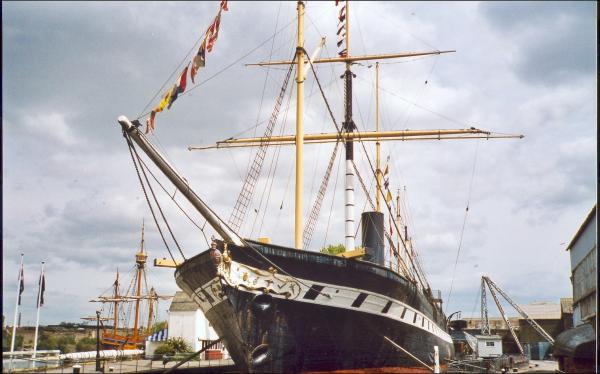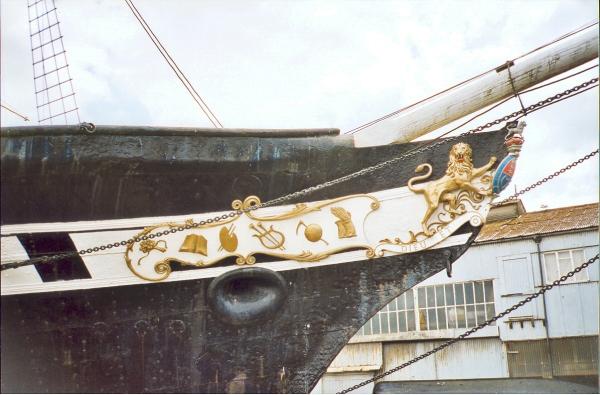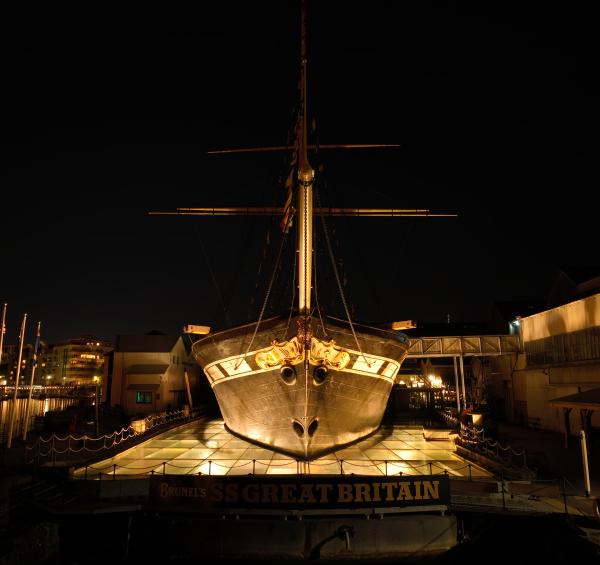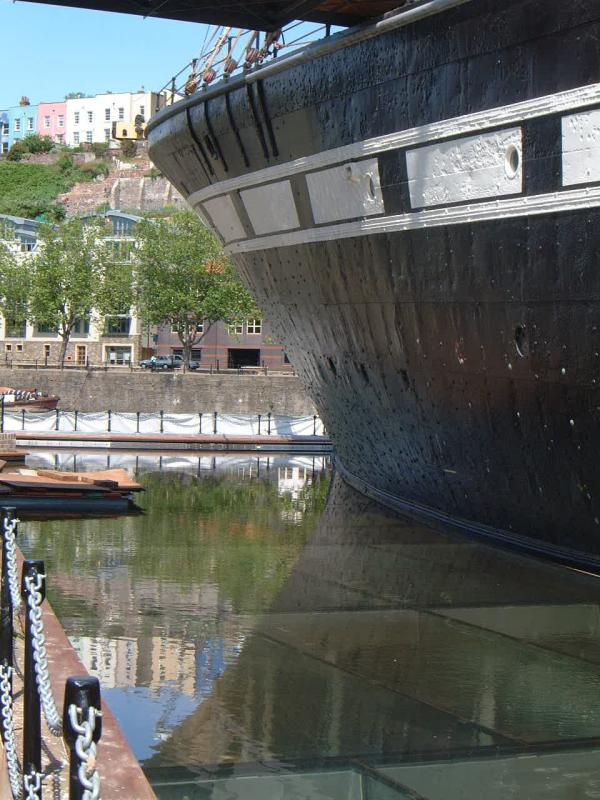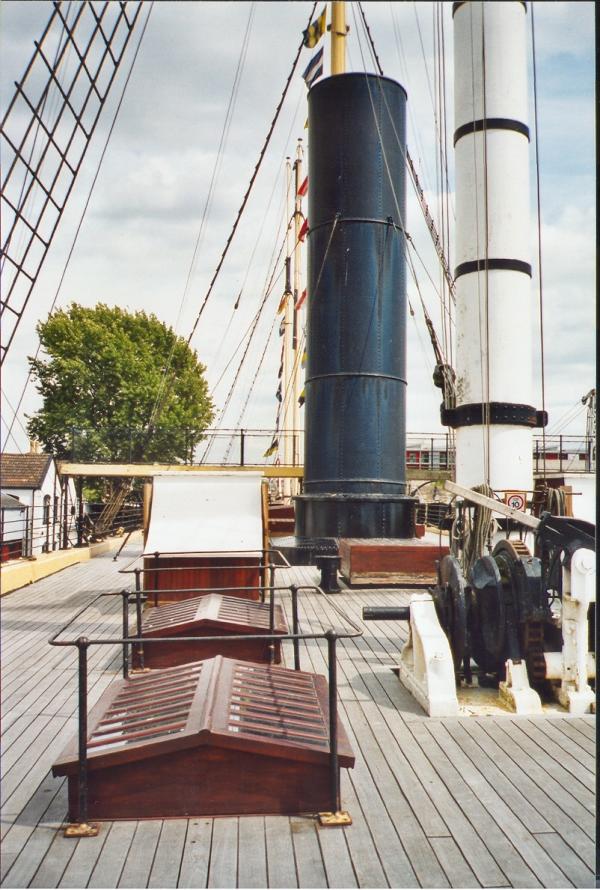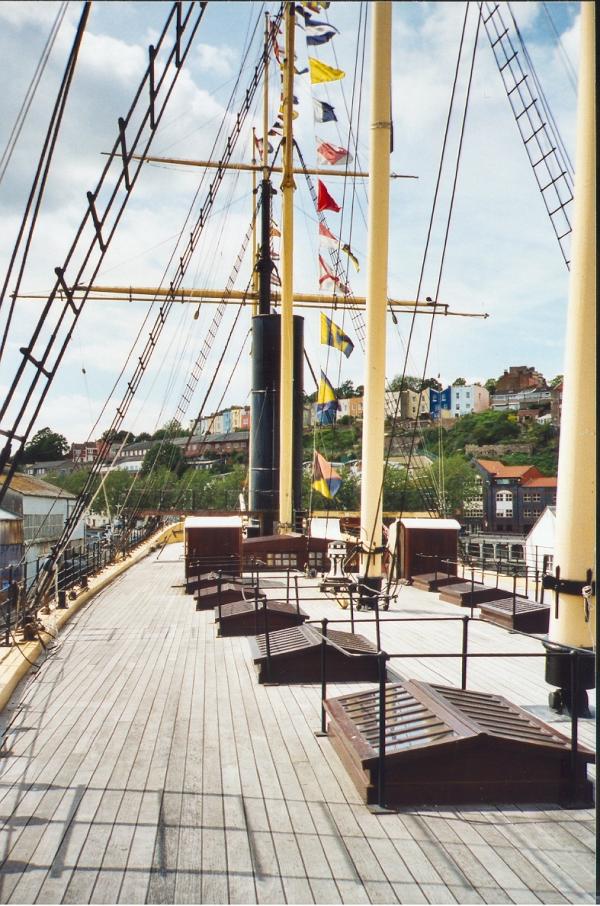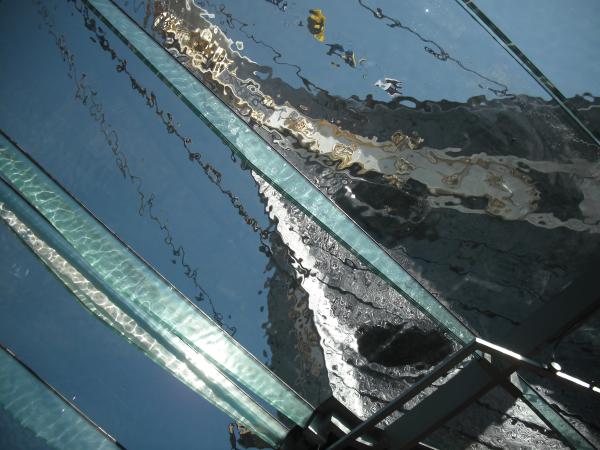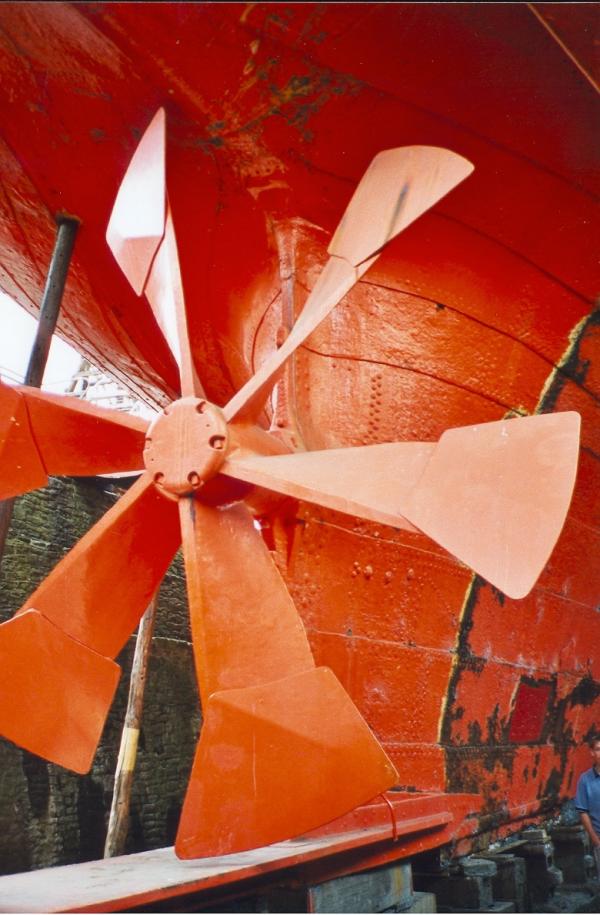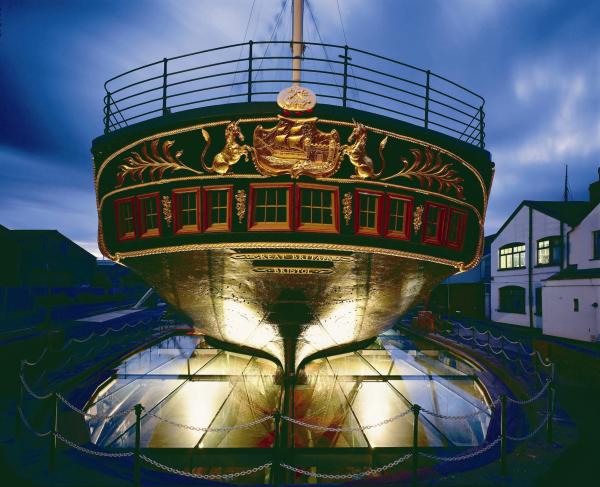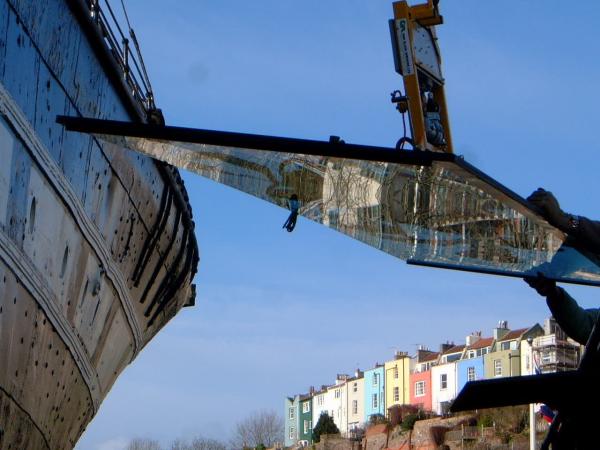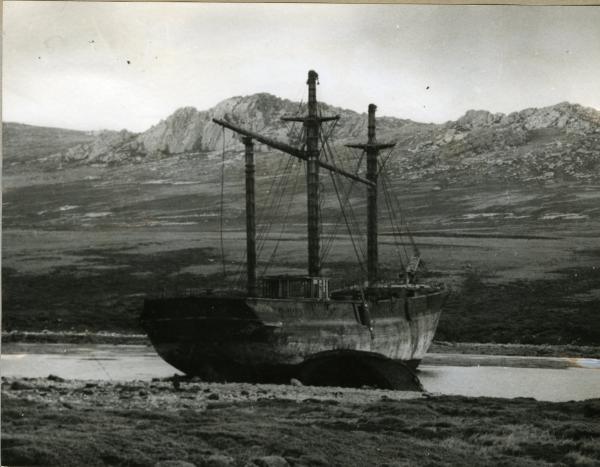
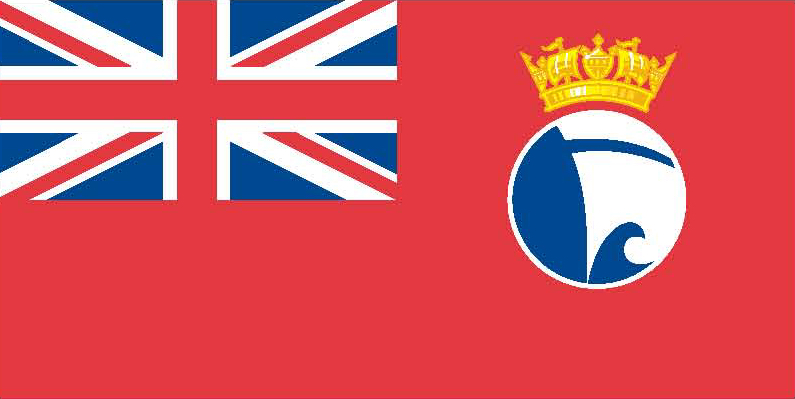
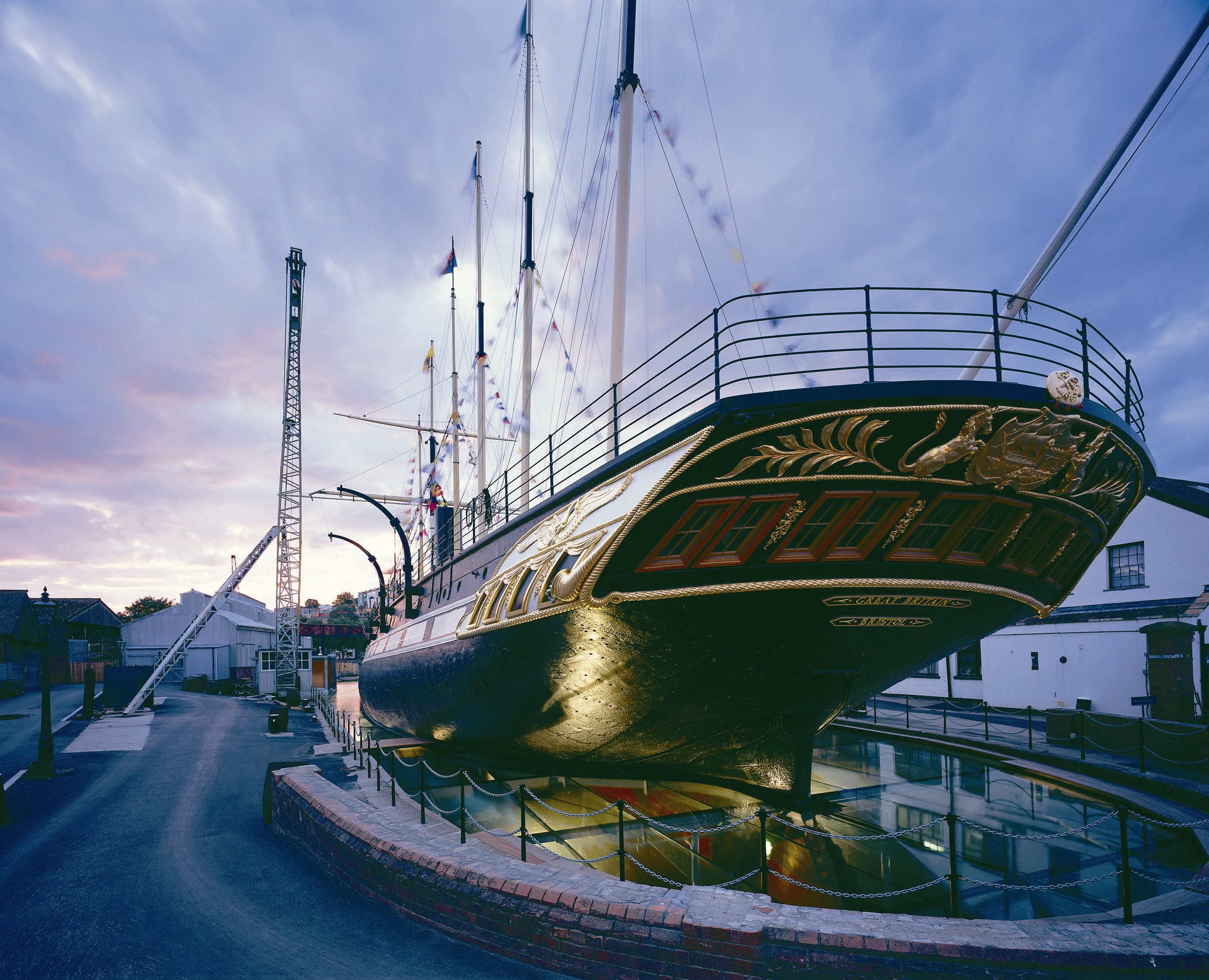
Details
Construction
Dimensions
History
When she was built in the nineteenth century the ss GREAT BRITAIN was a bold attempt by a British company to break the American monopoly of the trans-Atlantic passenger trade. Launched by Prince Albert on 19 July 1843, she was the largest and most technically innovative ship of her day. Her first voyage to America began on 26 July 1845, and she covered 3,100 miles in 14 days and 21 hours.
On the return journey, because of the loss of propeller blades, she used sail only, but still completed the voyage to Liverpool in 20 days. In 1846, however, on her fifth voyage, she ran aground in Dundrum Bay, County Down. It was not until August of the following year that she was refloated and towed back to Liverpool, and, in 1850, was sold to Gibbs, Bright & Co. for service to Australia. She was significantly altered at this time.
In 1854, she was refitted as a troopship for the Crimean War and again in 1857 she carried reinforcements to Bombay to deal with the Indian Mutiny. Returning to the Australian run, she carried the first touring English cricket side. In 1876, she was put up for sale at Birkenhead, but not bought until 1882. Her new owners, Anthony Gibbs, Sons & Co. converted her entirely to a sailing vessel for transporting coal to San Francisco and returning with wheat. After two such voyages, in 1886, she was dismasted by a hurricane off Cape Horn and she put into the Falkland Islands. As repairs were considered too expensive, she became a hulk for storing coal and wool. On April 14 1937, she was towed a few miles out of Port Stanley to shallow water in Sparrow Cove; holes were punched in her bottom and she settled on the seabed.
She had been launched in July 1843 and, after an interesting career, she found herself at Port Stanley in the Falkland Islands where a fire on board had damaged her beyond economic career. She was sold to the Falkland Islands Company and used, afloat, as a storage hulk (for coal and later wool) until 1937. It was in this role at 70 years old that she was destined to play an important part in the Battle of the Falkland Islands in December 1914.
At the end of October 1914, the German East Asiatic Cruiser Squadron under the command of Vice-Admiral Graf von Spee was on surface raider duties around the coast of South America. The squadron consisted of two powerful armoured cruisers, the SCHARNHORST and the GNEISENAU, and three lighters cruisers, the EMDEN, NURNBERG and LEIPZIG. On 27 October 1914, the German fleet put into Valparaiso on the west coast of Chile for coal. The Admiralty then sent a squadron under Rear Admiral Sir Christopher Cradock to hunt them down, and his ships were coaled from SS GREAT BRITAIN moored at the Falkland Islands.
Von Spee had been monitoring the squadron’s movements and headed towards the Chilean port of Coronel. On 1 November 1914 Cradock spotted Spee’s better armed squadron off the coast and decided to engage the enemy vessels. In the Battle of Coronel, which lasted less than an hour, two British armoured cruisers, HMS GOOD HOPE and HMS MONMOUTH, were sunk. The armed liner OTRANTO, along with the light cruiser HMS GLASGOW and an old battleship CANOPUS, retreated to the Falkland Islands.
The Admiralty gave orders to chase down von Spee, and a squadron under Vice Admiral Sturdee with two battle cruisers, HMS INVINSIBLE and HMS INFLEXIBLE was despatched to the South Atlantic. On 26 November 1914 they rendezvoused with the South American squadron under the command of Rear Admiral Archibald Stoddart in HMS DEFENCE, accompanied by HMS BRISTOL, HMS CAERNARVON, HMS CORNWALL and HMS KENT, together with HMS GLASGOW and nine colliers.
All the vessels were steam-powered and required enormous quantities of coal to operate. The vast hulk of the SS GREAT BRITAIN, afloat at Port Stanley in the Falkland Islands, acted as the principal means of re-coaling the Royal Navy’s South Atlantic fleet. Sturdee’s squadron arrived off Stanley on 7 December, and all except the battle cruisers began coaling, in either Port Stanley or Port William, a large anchorage immediately north of Stanley.
After his success at Coronel Spee decided to head home, but heard that the Falkland Islands were lightly defended, so he proposed to call in to destroy the port facilities and wireless station. He was unaware of the arrival of the British battle fleet. At 7.55 am on 8 December a four-funnelled warship was spotted on the horizon by lookouts at Sappers Hill, who telephoned the news to Port Stanley.
At 9 am two ships, which had been sent to reconnoitre, GNEISENAU and NURNBERG, came close to Port William where the ships were coaling. Sturdee’s flagship HMS Invincible was coaling alongside SS GREAT BRITAIN, a process that took two hours to complete. The German vessels first noted the tall masts of the wireless station, followed by a column of smoke, which rose, from the middle of the harbour. They assumed at first that this was the British firing the coal stocks on board SS GREAT BRITAIN, before spotting the tripod masts of two battle cruisers.
CANOPUS, beached on a mud bank as a guard ship, opened fire. Sturdee ordered a chase and the British fleet set off in pursuit. In addition to GNEISENAU and NURNBERG three other German warships were spotted, SCHARNHORST, LEIPZIG and DRESDEN. In the Battle of the Falkland Islands that followed SCHARNHORST, GNEISENAU, NURNBERG and LEIPZIG were all sunk. DRESDEN and KONINGSBERG escaped but were later caught and sunk.
Throughout the Battle, the great hulk of the SS GREAT BRITAIN lay at anchor within earshot of the gunfire that destroyed von Spee’s fleet. She subsequently became an object of great affection. Officers from the British Fleet visited her after the battle and she became a place of pilgrimage to seafarers and others throughout her life as a coal and later as a wool hulk. She was also seen as an important public monument by the Falkland islanders themselves.
SS GREAT BRITAIN continued in her role as a hulk until 1937. On April 14 1937, she was towed a few miles out of Port Stanley to shallow water in Sparrow Cove; holes were punched in her bottom and she settled on the seabed. In the Second World War, some of her iron was scavenged to repair HMS EXETER, one of the Royal Navy ships that fought the GRAF SPEE and was badly damaged during the Battle of the River. She remained at Sparrow Cove until 1970. In April 1970, she was re-floated, returning to her original dock Bristol in July that year where she underwent a major conservation programme.
The ship has been very carefully and sympathetically adapted to meet modern museum standards of visitor access. She is now a major visitor attraction in Bristol Harbour.
The organisation required to co-ordinate the task of recovery came into being in 1968, led by Dr Ewan Corlett. In April 1970, she was refloated, returning to her original dock Bristol in July that year where she underwent a major conservation programme.
In 2006, an appeal was launched to help restore the masts of the ss GREAT BRITAIN. Two of the masts and part of a third needed to be urgently replaced as they had become badly degraded. The vessel was successful in winning the prestigious Gulbenkian Prize as UK Museum of the Year 2006, which brought with it £100,000 in prize money. This was put towards the costs of the masts. The ship also won two awards at the Museums and Heritage Awards for Excellence 2006 conference in the restoration and conservation category as well as permanent exhibition. The project was also awarded the Civic Trust Award 2006 for accessibility. These Awards follow the relaunch of GREAT BRITAIN after work costing £11.3 million to transform her into a major visitor attraction and museum, as well as to preserve the vessel for future generations.
Significance
What is the Vessel’s ability to demonstrate history in her physical fabric?
Launched in 1843, ss GREAT BRITAIN is of outstanding international significance in view of the technological advances expressed in her structure, machinery and fittings. The hull, which remains substantially complete from the time of her construction in Bristol, is of wrought iron riveted plates on wrought iron frames, and at the time was the largest iron vessel ever built, the largest ship in the world, the first large screw-propelled ship, and the first trans-continental vessel to be designed to operate to a timetable. In addition to the hull, the tubular riveted iron main yard from the original configuration also survives and is displayed alongside in the ship’s museum. The masts and spars are reconstructions of the original transatlantic fore and aft configuration with only 2 square sails on the foremast. This rig was designed to assist passage making by allowing the ship to sail close-hauled into the westerly winds. Brunel’s design incorporated the after masts being hinged at deck level, and these form part of the faithful extreme reconstruction of the 6 masted sail plan. The ship is displayed with a replica of Brunel’s first 6-bladed propeller in place. The later lifting propeller gear from her sailing period is on display in the associated museum.
The interior of the ship has been reconstructed and replicated to the highest research standards using primary sources to interpret different parts of the ship at particular times in the vessel’s long life. The promenade deck, adjacent cabins, and dining saloon have been replicated to represent what was there in 1843. The original steam engine and chain drive have been replicated and, along with the ship’s galley, are from that period too. Portside accommodation is presented at the time of the Crimean War, when ss GREAT BRITAIN acted as a troop ship, whilst the forward accommodation is a reconstruction of the steerage accommodation from her time as an emigrant ship, based on contemporary plans, drawings, accounts and diaries. A forward section of the hull incorporates a display of the ship carrying horse during the Crimean War, whilst the very fore-most area of the hull has been left unreconstructed to show the original form of the frames and hull plating.
The conservation and reconstruction of ss GREAT BRITAIN has been predicated on 2 key principles: accuracy, and the capacity to accommodate and encourage activities involving visitors of all ages and backgrounds within the ship, on deck, and where possible engagement with the ship’s rig.
What are the vessel’s associational links for which there is no physical evidence?
ss GREAT BRITAIN's associational links are very wide-ranging. First and foremost she is the brain-child of IK Brunel, whose impact on engineering and travel is of international significance. The ship was originally conceived as the logical extension of the Great Western Railway in which Brunel was a prime mover. After her stranding and recovery from Dumdrum Bay (Ireland) the ship was bought by Gibbs Bright & Co, whose principal, William Gibbs, was instrumental in financing and backing the building of the Great Western Railway, and who built the remarkable Tyntesfield House near Bristol, with its own private rail stop on the Great Western line. William Gibbs was also present at the opening of the Clifton Suspension in 1864, five years after Brunel’s death.
Contemporary accounts, paintings, illustrations and photographs record the ship’s associations with the Crimean War, her role as an emigrant ship carrying some 25,000 people to Australia, the carrying of special groups such as the first English Cricket Eleven, and her role as a depot ship in the First World War.
How does the vessel’s shape and form combine and contribute to her function?
Specifically built to steam across the Atlantic, ss GREAT BRITAIN had to be of sufficient size and proportion to carry the necessary fuel to power the steam engine. This demanded the huge hull which Brunel designed in order to house engines, bunkers, supplies and the number of passengers needed to make the ship economically successful. All of this can be seen in the ship today. The specific sailing requirements for west-bound vessels are reflected in the fore and aft rig (see above). Internally the levels of accommodation reflect social differences, the demands placed on the ship as her function shifted over time, and changes in the legislation applied to passenger vessels. The reconstructed galley and steerage larder are of particular interest as reflections of different passenger status and expectations.
The ship has been very carefully and sympathetically adapted to meet modern museum standards of visitor access.
In view of her outstanding significance ss GGREAT BRITAIN is listed in the National Historic Fleet of the National Register of Historic Vessels.
Key dates
-
1843
Vessel launched by Prince Albert on 19 July
-
1845
First voyage to America
-
1846
Ran aground on the sands of Dundrum Bay in Northern Ireland
-
1850
Sold to Gibbs, Bright & Co. for service to Australia
-
1854
Refitted as a troopship for the Crimean War
-
1857
Carried reinforcements to Bombay during the Indian Mutiny
-
1882
New owners, Anthony Gibbs, Sons & Co., converted her entirely to a sailing vessel for transporting coal to San Francisco returning with wheat
-
1886
Dismasted by a hurricane off Cape Horn, put into the Falkland Islands
-
1937
Beached and abandoned a few miles from Port Stanley
-
1970
Refloated and returned to her original dock in Bristol to undergo major conservation
-
2006
Vessel won the prestigious Gulbenkian Prize as UK Museum of the Year 2006, which brought with it £100,000 in prize money
Grants
-
March 2023
SS Great Britain Trust has been awarded a grant of £728,985 grant from DCMS/ Arts Council England's Cultural Investment Fund towards replacing the Weather Deck of the SS Great Britain.
-
November 2021
SS Great Britain Trust received a Continuity Support grant of £429,705 from round 3 of the Culture Recovery Fund.
-
October 2020
SS Great Britain Trust received a grant of £888,186 from round 1 of the Government's Culture Recovery Fund.
- 2020 Awarded £440,000 from the second round of Culture Recovery Funding
-
22 April 2015
£50,000 awarded to ss Great Britain from The Headley Trust towards the cost of the 'Being Brunel' project
-
2013-2014
The Heritage Lottery Fund awarded £500,000 for conservation
-
2012-2013
The Heritage Lottery Fund awarded £84,300 restoration of the special rig which Brunel designed to assist the steam powered screw propeller
-
2008-2009
The Heritage Lottery Fund awarded £50,000 for documenting, collecting and conserving the memories of those who participated in the salvage and return of the vessel in 1970
-
2007-2008
The Heritage Lottery Fund awarded £640,000 for conservation and a learning centre
-
2006-2007
The Heritage Lottery Fund awarded £3,475 for an activity day designed to involve visually impaired people
-
2006
A grant of £30,000 was awarded by Rolls Royce Plc for engine restoration
-
2005
A grant of £30,000 was awarded by Rolls Royce Plc for engine restoration
-
2005
A grant of £30,000 was given towards the restoration appeal by The Headley Trust
-
2004
A grant of £40,000 was given towards the restoration project by The Headley Trust
-
2001
A grant of £50,000 was given towards conservation by The Headley Trust
-
2000-2001
The Heritage Lottery Fund awarded £9,205,000 for conservation of the iron fabric
-
1997
The National Heritage Memorial Fund awarded £86,140 for restoration work of the mast and spars
-
1996-1997
The Heritage Lottery Fund awarded £67,500 for developing the main application for restoration, conservation and development
-
1995
The National Heritage Memorial Fund awarded £13,000 for restoration work of the mast and spars
-
1995
The National Heritage Memorial Fund awarded £106,000 for restoration works
-
1994
The National Heritage Memorial Fund awarded £189,000 for restoration of the deck
-
1987
The National Heritage Memorial Fund awarded £25,000 for restoration of the skylight
Sources
Brouwer, Norman J, International Register of Historic Ships, Anthony Nelson, pp152, Edition 2, 1993
Sullivan, Dick, Old Ships, Boats and Maritime Museums, Coracle Books, 1978
Blake, Joe, Restoring the Great Britain, RedCliffe Press Ltd, 1989
The SS Great Britain Official Guide, The Macmillan Press Ltd, 1971
Classic Boat: Matthew joins Great Britain, December 2011
Corlett, E C B, Mariner's Mirror: The Stranding of the SS Great Britain in Dundrum Bay, pp117-126, Volume 61, Edition 61, 1975
Maritime Wales: The SS Great Britain as the world's first six-masted schooner, Gwynedd Archive Services, Volume 9, 1985
Sea Breezes: The 'Great Britain'; Progress Report, July 1983
Lumsden, Robert J, Ships Monthly: Brunel's Three Great Ships, pp22-27, December 1975
Ships Monthly: Ships Preserved: No 6 Brunel's Great Britain, June 1975
Own this vessel?
If you are the owner of this vessel and would like to provide more details or updated information, please contact info@nationalhistoricships.org.uk

